BRIDGES to BEYOND
NORTH ROAD.
The first permanent connections with the mainland
were built as part of the Devonshire and Buccleuch Docks
systems. A hydraulically operated iron girder bridge was
erected between the entrance basin & Devonshire Dock to
provide a narrow roadway & railway link to northern Old
Barrow.
The link followed the route of an ancient ford from
Hindpool to Crow Nest Point, known as the "North Way",
hence North Road. In early times the ford just to the north
of the site of Michaelson Road Bridge was known as the
"Middle Way" or "Middle Road", [to Old Barrow]. Strangely
this ford was also known as 'Bewley Wife Steps.'
When the [later] "High-Level Bridge" was built; North
Road, right up to
recent times, was
known as the "Low
Road" as distinct
from the Michaelson
(High Level) Road
Bridge. When the
northern entrance to
Devonshire Dock fell
into disuse, a
caisson at North
Road was sealed in
place & the top of it
can still be seen just
inside VSEL
perimeter fence.
Now that the infill of
Devonshire Dock is
complete, we have a
fixed connection
with Barrow. The
tarmaced road with
traffic light
controlled junction is a far cry from a bridge wide enough for a horse & cart or a railway wagon: but not at the same time.
The Graving Dock alongside the original Devonshire Dock entrance basin is now "The Dock" maritime museum, the
basin itself is the car park. At the rear of the car park, the massive hinges on which Devonshire Dock gates swung could
still be seen in the 1980s. To one side, a capstan used to open the gates by hand is still in place and nearby the hydraulic
pumps. Although they too may have buried under tarmac. (see above).
Above & Right: The Graving Dock in use and disused, now forms
the lower floor in the Dock Museum
f
THE "HIGH-LEVEL BRIDGE" (Michaelson Road Bridge).
The Michaelson Road High-Level Bridge has, unlike the necessity for an opening span at North Road, increased in
importance over the years. The first structure was, in fact, a Low-Level bridge. Devonshire Dock opened in October 1867,
but Buccleuch Dock was not completed until February 1873.
In the intervening years,
Devonshire Dock was sealed from the
tide by gates at Walney Channel and
an embankment at the [now]
Michaelson Road end, which left the
south end of Barrow Channel still open
to the sea. The embankment provided
access to Barrow Island until
Buccleuch Dock was finished when an
opening bridge became necessary to
connect the two new docks. A new
embankment was then built from
Cunninger Point on Old Barrow to the
mainland at the south end of
Buccleuch Dock.
The approach to the original swing bridge that the High-Level Bridge replaced from the town side sloped gently
downhill to quay level and across, the then forty-foot opening, then uphill to Old Barrow. The bridge itself was a two-leaf
swing bridge, hydraulic power coming from a pumping station on the town side of Devonshire Dock, which also supplied
power for the Graving Dock gates and North Road Bridge as well as various cranes and capstans.
Increased and larger maritime traffic could gain access to the docks system when the Ramsden Dock entrance was
opened in 1879. At a stroke, this made the forty-foot span of the original swing bridge inadequate. The bridge itself was
also inadequate for the increasing demands made by the growing shipbuilding industry on Barrow Island. A fine Victorian
design for a 'high level' bridge was drawn up. It was
an unusual design inasmuch that the entire opening
span raised itself bodily above the level of the
approach road, then drew itself horizontally on wheels
over to the town side abutment. Hence its technical
name 'Lifting Drawbridge'. The foundations on the
town side consisted of large 'rafts' of concrete, which
is still accepted modern-day practice. However, on the
island side of the channel, a method in line with
modern practice was used: but the material employed
was not. The foundations on the Barrow Island side
consisted of timber piles driven into the ground then
capped with concrete. The finite life span of timber
and its virtually unknown condition, buried deep in the
earth was an element consultants surveying possible
designs for a new bridge 75 years later, had to
consider carefully.
The bridge approach sections, made of wrought-
iron, were supported on massive cast-iron pillars. The
opening was enlarged to seventy-nine feet six inches &
two completely separate and independent opening
spans were provided, again the load-bearing parts
were made of that Victorian wonder-metal wrought
iron, planked with timber.
To digress slightly, how many Old Barrow children
have crossed the old High-Level Bridge and looked
through the gaps in the planking - then gone to bed
that night to have nightmares about falling through
the gaps - am I alone? I think not.
Hydraulically operated, the bridge machinery
lived in a hollow section in the brick & stone pier on
the town side. Power as before was tapped from the
Devonshire Dock Pumping Station built by Sir W.G.
Armstrong of Elswick. [Yes, the same Armstrong later
involved with Vickers]. The 100hp steam-driven pump
delivering water at 750psi was more than adequate,
and large accumulators ensured delivery pressure was
constant. The first span was completed in 1882, but
the second was delayed while modifications were
carried out to allow for unforeseen extra loads
imposed by trams. Unforeseen, that is until the Barrow in Furness Tramways Act was passed in 1883. The second span was
completed in 1886 - except for a short length of the tramway that was curiously missing.
Such was the soundness of the design & construction that when it was finally demolished in the late 1960s, it was
thought, by one school of thought to be good for another 25 years of use. An engineering survey, however, showed the
wrought iron cross members under the timber planking on the movable span to be over-stressed by vehicles of more than
four tons. [So the nightmares were not entirely without foundation - if you'll pardon the pun]. The brick-built approach
arches over Hindpool Road, due to increased traffic loads were another cause for concern. In 1939 plans were mooted for a
replacement bridge. The cost in those pre-war days was estimated at £130,000, but with the commencement of hostilities,
the plan was shelved.
PLANS FOR A NEW BRIDGE
It wasn't until 1958 that a new bridge was again considered necessary. Barrow Borough Council employed London
based Consultant Engineers; Messers Mott, Hay & Anderson to produce proposals, costing estimates, explore possible
methods of construction & produce preliminary drawings. After some unavoidable delays, a report & proposals arrived for
the Highway's Departments consideration.
Five types of opening-span were considered:
a. A DRAWBRIDGE. similar to the old one, this was rejected mainly because the foundations would require
strengthening over a far greater area, [the whole area the movable span would traverse], with a resultant greater cost.
b. A SWING BRIDGE. similar to the original low-level
bridge of the 1860s, this also was rejected because its
construction would completely close the road for upwards of
two years.
c. A VERTICAL LIFT BRIDGE. was dismissed out of hand
due to the complication & extra expense involved building
the necessary lifting towers on both sides of the dock.
d. A ROLLING LIFT BRIDGE. Vickers expressed their
approval of this type, combined with widening the passage
for ships to 100 feet. Very nice of them to give it the nod,
but they were not prepared to stump up some £££'s to help
the project become a reality. After all, they would have been
the main beneficiaries of any improved access over or under
the bridge. In the end, this design was considered to have
the same inherent disadvantages as a drawbridge; the
vertical load moves horizontally as the bridge rolls, making
strong foundations over a greater area essential.
e. A BASCULE (Trunnion) BRIDGE. Two variations of this type were considered; the double-leaf & the single leaf. The
double-leaf was quickly discarded. This type splits at mid-span & requires extra foundations at both ends two
accommodate two sets of machinery. So the design finally accepted was for a single leaf Bascule (Trunnion) Bridge, & that
is what we have today. An advantage of this design is when the bridge is being raised the downward forces exerted by the
dead weight load of the span structure pass directly through the trunnions, or
pins, on which the whole structure pivots. Therefore only a relatively small
area needs really strong foundations. Turning forces (moments) created by
the overhanging leaf during the lifting operation are negated by massive
counter-weights. In fact, the present Michaelson Road Bridge is so finely
balanced; it is designed to be lifted by hand. It has been calculated that one
leaf could be raised by four men in one & three-quarter hours, using the
removable capstans provided.
The Town Council's Highways Committee spent several years haggling
over sharing costs for the new bridge with the old British Transport Docks
Board, (who were responsible for bridge maintenance, and it was considered
the 1886 bridge to be good for another 25 years service. Vickers, on the
other hand, who didn't think the advantage to their operations worth the
expenditure required. The Council's bickering nearly lost us the chance of a
new bridge altogether so, in the end, an exasperated Ministry of Transport
forced the issue.
In 1963 the Ministry offered a grant of 75% of the total building costs,
some £510,075. They also offered to pay the full cost of building the new
bridge to 'HB-Special Loading Requirements' standard - another £21,500.
The offer, however, was couched in 'make your mind up and take the money
now - or lose it' terms. The threat of the grant being withdrawn spurred the
Council into a frenzy of inactivity, and it wasn't until 1964 that Mott, Hay &
Anderson put the job out to tender, the estimated cost having risen in the
meantime to £749,892. A contract with McAlpines was signed and work
started in 1965.
The fact that the old bridge's moving span was constructed in two
separate halves was put to good use when the new bridge was built. It too
was designed to operate in two halves, split lengthways. The plan, which
worked well in practice entailed using the span of the old bridge nearest Buccleuch Dock for two-way traffic, while the
Devonshire Dock span was demolished. That side of the present bridge was then erected in the fully open position. When
completed, it was then lowered, commissioned and the trick reversed. The new bridge, although built in two halves which
can be operated individually, it is normally lifted as a single span.
The new Michaelson Road Bridge was formally opened by the Rt Hon Earl of Derby MC on the 29th July 1968.
A BRIDGE TOO FAR
Barrow Island, like a giant's stepping-stone, provides Barrow's link with Walney. In the last century, numerous fords
were the only means of getting to Walney, [Good enough for 'em, I say]. When most of the fords were swept away by
dredging, several entrepreneurs acquired rowing boats and
set themselves up as ferrymen. Later as Walney began to
develop, the land-owners began agitating for a proper ferry.
A campaign conducted through the pages of the Barrow
Herald galvanised the rest of Barrow's populace into frenzied
indifference. The campaigners led by a school-master called
[appropriately] Mr J.R. Head, who taught at the school built
on the promenade by Mrs Michaelson; discovered they could
sue the Furness Railway on the grounds of injury to their
lands by reduced access.
In 1877, the Furness Railway settled out of court by
promising to provide a ferry within nine months. It was
written into the agreement that the Walney land-owners could
travel for half-price. (The Furness Railway slyly dropped this
concession when the contract was modified later). It was also
agreed the ferry would run from 5.30 am to midnight.
With a resounding splash, Barrow Shipbuilding Company
proudly launched a metal box named 'Steam Ferry No1 in
1878. After twenty-four years service, 'No1' was replaced with
another metal box, imaginatively christened 'Steam Ferry
No2'.
The Corporation bought land on Biggar Bank in 1881 for
use as a public recreation area for the townspeople; now
people actually wanted to go to Walney! Not satisfied with
their new ferry, they now clamoured for a bridge.
Another newspaper, the 'Vickerstown Chronicle' was
published from 1902 to 1904 to further the cause. The
Corporation and [naturally] Vickers were keen to have a
bridge built. Still, the Furness Railway argued a bridge would
be a navigation hazard to ships using the Graving Dock and
expressed a preference for a tunnel or subway. There was
much gnashing of teeth when the bridge got the go-ahead
because they had just bought the ungrateful Walneyites a
new ferry.
Sir William Arrol Co of Glasgow built the bridge at a cost
of £175,000. A toll was levied to defray part of construction
costs. Opened in 1908 by Mrs T.F. Butler, Mayoress of Barrow,
the SS Philomel steamed through the spans dressed overall to
mark the occasion. Twenty-seven years later, to celebrate King
George V and Queen Mary's Silver Jubilee, the toll was lifted,
to this effect a commemorative plaque was unveiled at the
east end of the bridge by the Duchess of York.
The grandly named, but now redundant 'Steam Ferry
No2' was transferred to Southampton.
Now in its 112th year and probably the oldest surviving
rack and pinion actuated bridge in Britain, Walney Bridge is
showing its age. There have been proposals to permanently fix
it in the down position, maintenance costs again being the
bugbear of these old but magnificent structures. Although the
passage has not been used by commercial shipping for very
many years, the idea has not been welcomed by yacht owners
north of the bridge and other interested parties.



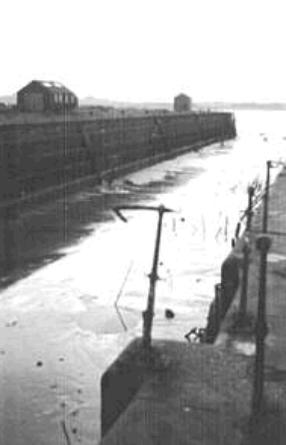
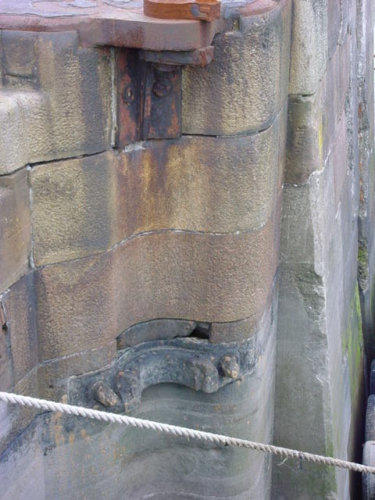

Left: All that was left of the original Devonshire Dock
gates.
Above: All that remained of the caisson, (top picture). This
may be gone now with the latest bout of building work by BAE.




That small bridge was shared by trains, cars, motorbikes
& the brave on push bikes.
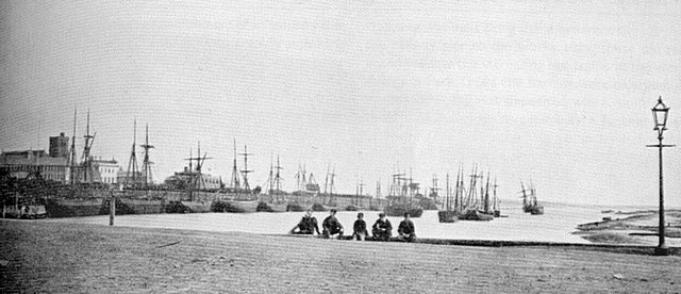
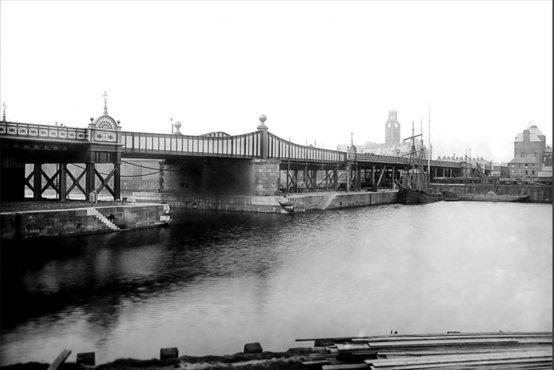

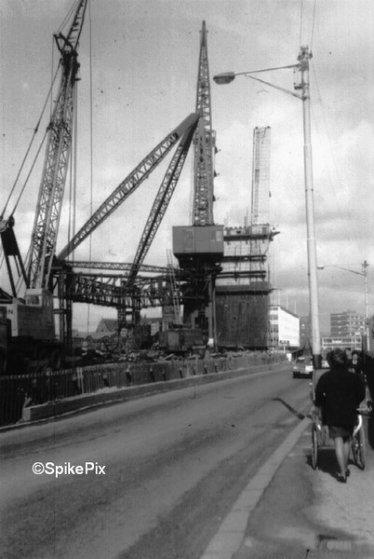
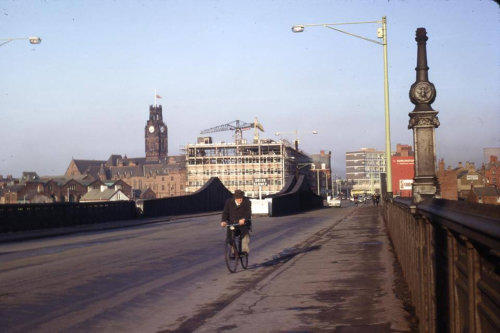
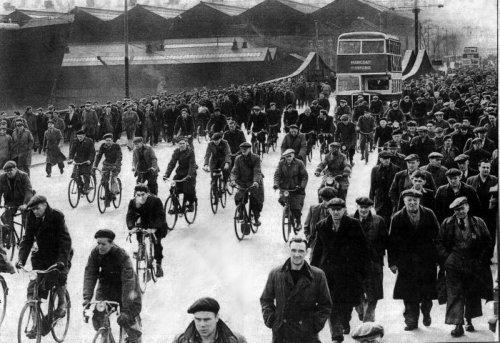
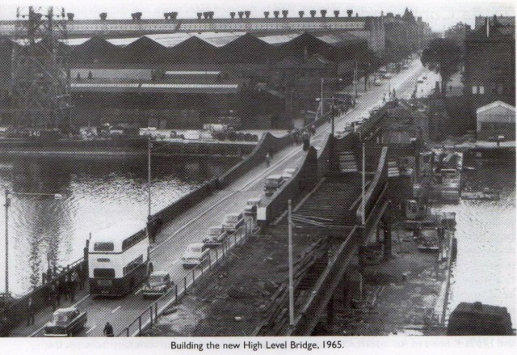


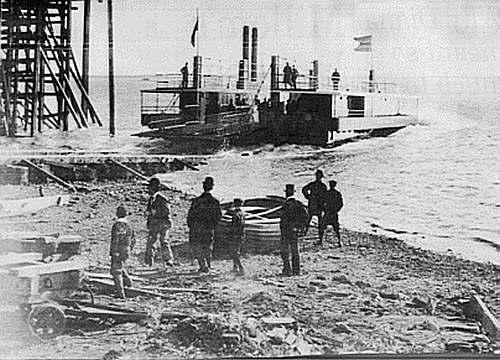


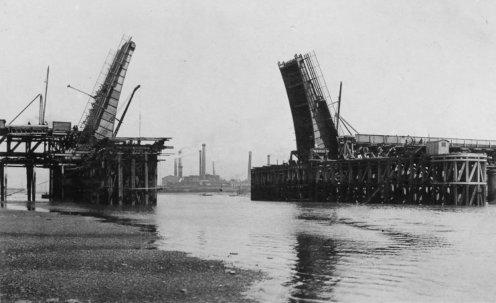
ABOVE: Bridge span open while under construction.
RIGHT: World War I tank attacks Biggar Bank.


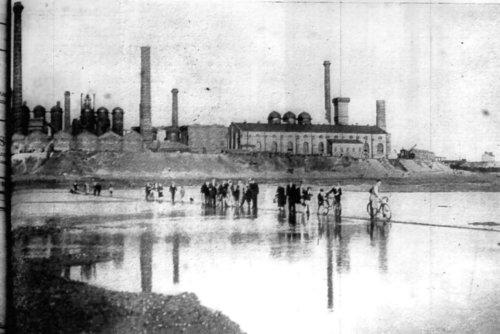
Walneyites return home after sight-seeing on
Barrow Island

When the Duchess Of York freed the bridge of toll they
could cross for no charge. (Just like the ford).

20th century
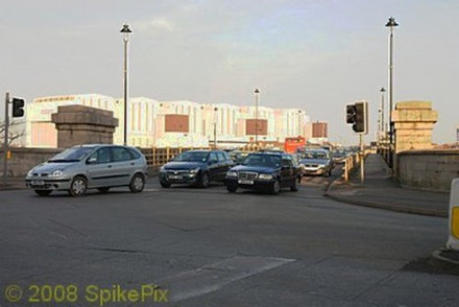
21st century, and they lecture us about pollution
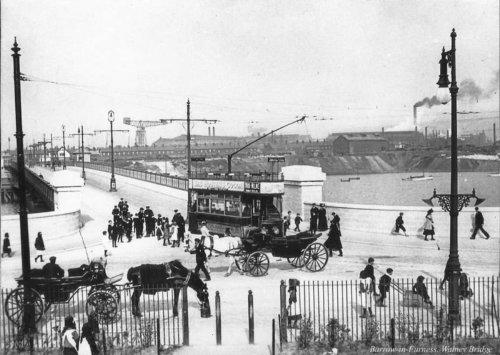

Left: c. 1910 and 1975 (© Peter Steel).

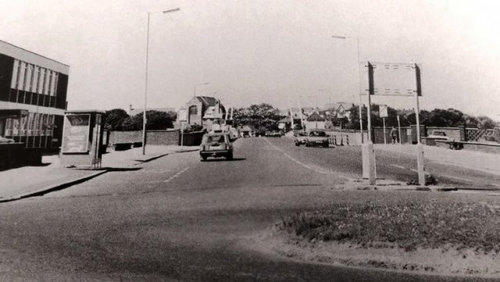
Bridge Approach from Barrow Island. From tramlines to
a roundabout & in 2020 traffic lights are now a necessity.
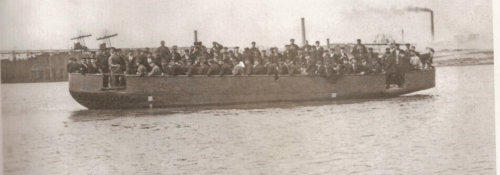

Another shortcut from the shipyard to Walney. The
beautiful ‘Mudlark’ takes to Walney Channel, and may God
help all who sail in her.
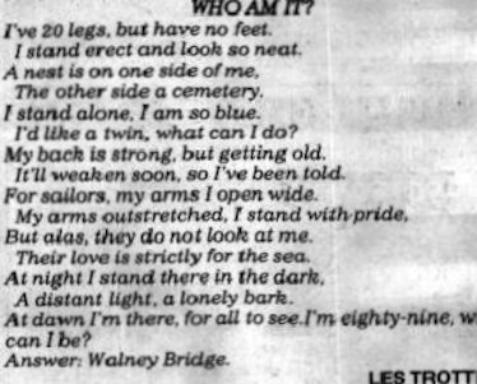
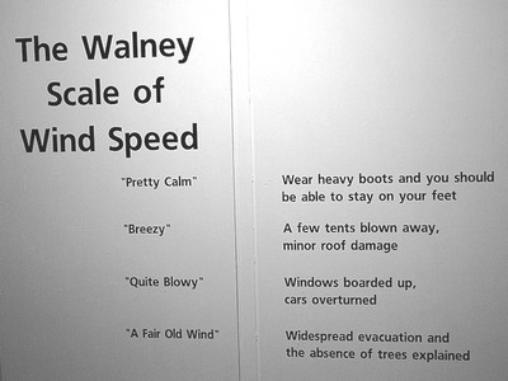
Some time ago Les Trotter wrote a poem about Walney Bridge.


